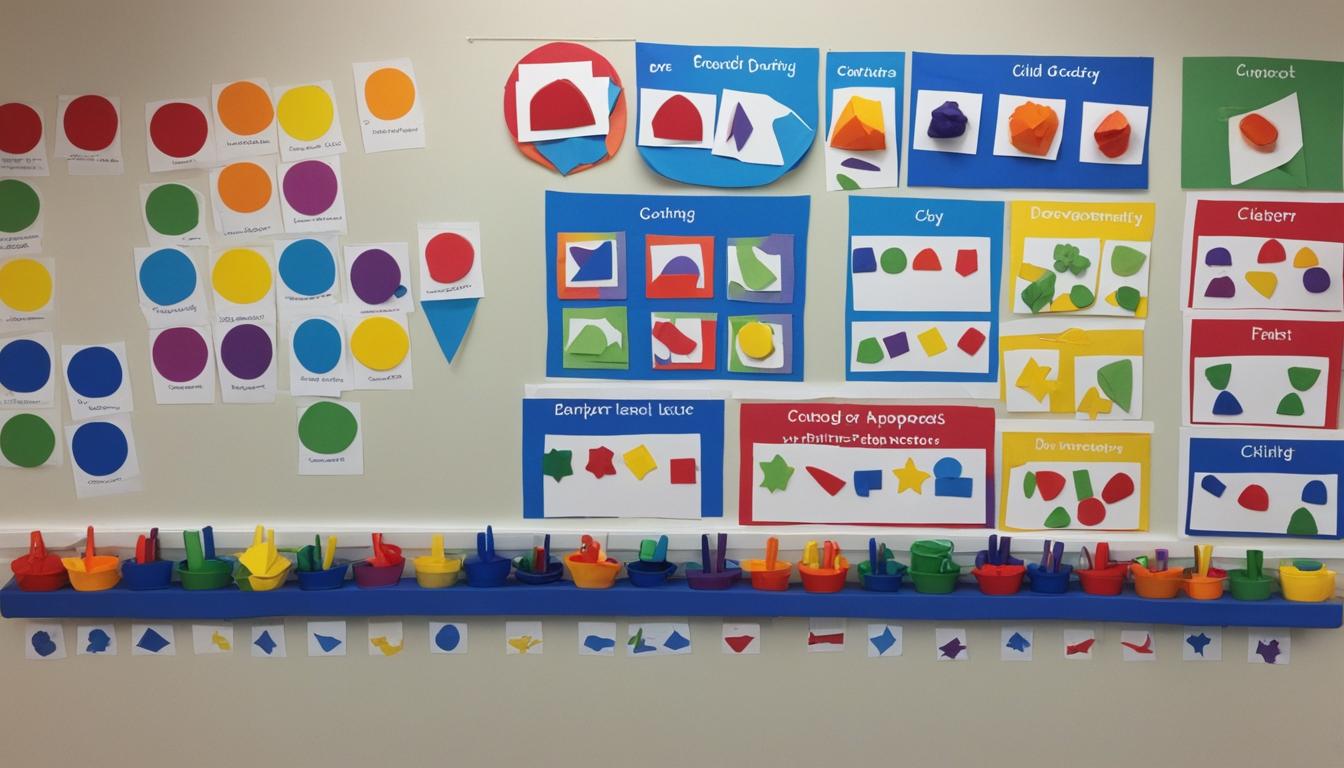Embracing Developmentally Appropriate Practice in Early Childhood Programs
Giving young children the best start in life is a priority for any early childhood program. That’s why it’s crucial to understand and implement developmentally appropriate practice (DAP) in our approach to education. DAP is about tailoring teaching strategies and curriculum to meet the unique needs, interests, and abilities of each child. It recognizes that children learn and develop at their own pace and in their own individual ways.
At its core, DAP promotes the use of play-based learning, hands-on activities, and meaningful experiences that are relevant to a child’s daily life. By providing engaging and age-appropriate learning opportunities, we can foster optimal growth and learning in young children.
Key Takeaways:
- DAP tailors teaching strategies and curriculum to meet the unique needs of each child in early childhood programs.
- Play-based learning, hands-on activities, and meaningful experiences are essential components of DAP.
- DAP promotes optimal growth and learning in young children by providing engaging and age-appropriate learning opportunities.
- Recognizing and valuing each child’s individuality is an important aspect of DAP.
- Implementing DAP in early childhood programs creates a positive and inclusive learning environment.
Benefits of Developmentally Appropriate Practice in Early Childhood Programs
Numerous studies have highlighted the benefits of implementing developmentally appropriate practice in early childhood programs. Research has shown that DAP promotes positive outcomes in children’s cognitive, social-emotional, and physical development.
- Enhances children’s problem-solving skills, critical thinking abilities, and creativity.
- Supports the development of self-regulation, social skills, and emotional intelligence.
- Creates a positive learning environment that is nurturing, inclusive, and respectful of each child’s individuality.
- Promotes engagement, motivation, and a love for learning by tailoring instruction to meet the specific needs of each child.
By implementing DAP, educators can provide opportunities for children to explore, experiment, and make meaning from their experiences. This approach recognizes that children learn best when they are actively engaged and challenged at their own level, rather than being forced into standardized learning expectations.
“The research is clear – when we provide developmentally appropriate experiences, we set a strong foundation for lifelong learning and success.” – Dr. Anna Johnson, Child Development Specialist
Additionally, DAP fosters a sense of belonging and community within early childhood programs. By valuing each child’s unique strengths and interests, educators create an environment where children feel seen, heard, and supported. This sense of belonging can have a profound impact on children’s overall well-being and their willingness to take risks and explore new ideas.

| Benefits of DAP in Early Childhood Programs | Description |
|---|---|
| Enhanced cognitive development | Children develop advanced problem-solving and critical thinking skills. |
| Positive social-emotional development | Children learn to regulate emotions, build relationships, and develop empathy. |
| Promotion of physical development | Children gain gross and fine motor skills through play and movement. |
| Fostering creativity | Children are encouraged to explore and express themselves through art, music, and imaginative play. |
| Individualized learning | Instruction is tailored to meet each child’s unique needs and abilities. |
By implementing developmentally appropriate practice in early childhood programs, educators create a solid foundation for lifelong learning and success. The benefits extend beyond the early years, shaping children into confident, resilient, and motivated learners.
Strategies for Implementing Developmentally Appropriate Practice in Early Childhood Programs
Implementing developmentally appropriate practice (DAP) is crucial for early childhood programs to create optimal learning environments for young children. Educators can employ several key strategies to effectively implement DAP and promote the holistic development of children.
Create a Supportive and Stimulating Learning Environment
To implement DAP, educators must first prioritize creating a supportive and stimulating learning environment that caters to the diverse needs and interests of young children. This includes providing a wide range of age-appropriate toys, books, and learning materials that encourage exploration and hands-on experiences. By offering a variety of resources, children can engage in meaningful play and develop their cognitive, social, and emotional skills.
Observe and Assess Children’s Development
Active observation and assessment are vital in implementing DAP effectively. Educators should regularly observe and assess children’s development to inform their instructional practices and tailor learning experiences accordingly. This involves using both formal and informal assessment methods, such as observations, checklists, and portfolios, to gather data on children’s progress and identify areas for growth. By understanding each child’s unique strengths and needs, educators can provide personalized support and scaffold their learning effectively.
Collaborate and Partner with Families
Collaboration and partnership with families play a crucial role in implementing DAP. Educators should actively engage with families, forming a strong home-school connection to support children’s learning and development consistently. Regular communication, parent-teacher conferences, and involvement in decision-making processes contribute to creating a cohesive and inclusive learning environment. By collaborating with families, educators gain valuable insights into each child’s background, experiences, and individual needs, enabling them to provide truly individualized instruction.
Reflect and Engage in Professional Development
To continually improve and stay updated on best practices, educators should prioritize self-reflection and engage in ongoing professional development. Reflecting on their own practices allows educators to identify areas for growth and refine their teaching strategies to better meet the diverse needs of children. Additionally, participating in professional development opportunities, such as workshops, conferences, and online courses, enables educators to stay informed about the latest research and evidence-based approaches in early childhood education.
Implementing developmentally appropriate practice in early childhood programs requires a strategic approach that prioritizes creating supportive environments, observing and assessing children’s development, collaborating with families, and engaging in continuous professional growth. By implementing these strategies, educators can ensure that early childhood programs provide enriching and developmentally appropriate experiences for young learners.

| Benefits of Implementing DAP | Strategies for Implementation |
|---|---|
| Promotes optimal cognitive, social, and emotional development | Create a supportive and stimulating learning environment |
| Enhances problem-solving skills and critical thinking abilities | Observe and assess children’s development |
| Supports the development of self-regulation and social skills | Collaborate and partner with families |
| Fosters engagement, motivation, and a love for learning | Reflect and engage in professional development |
Conclusion
Implementing developmentally appropriate practice (DAP) in early childhood programs is crucial for promoting optimal learning and growth in young children. By tailoring instruction to meet the individual needs, interests, and abilities of each child, DAP fosters positive outcomes in cognitive, social-emotional, and physical development.
DAP creates a supportive and inclusive learning environment that encourages engagement, motivation, and a love for learning. By employing key strategies such as creating a stimulating environment, individualizing instruction, collaborating with families, and engaging in reflective practice, educators can effectively implement DAP in early childhood programs.
This comprehensive approach ultimately contributes to the overall success and well-being of young children, allowing them to reach their full potential. By embracing DAP, early childhood programs can provide a solid foundation for children’s future academic and personal achievements.
FAQ
What is developmentally appropriate practice (DAP) in early childhood education?
Developmentally appropriate practice (DAP) refers to the use of teaching strategies and curriculum that are tailored to meet the individual needs, interests, and abilities of young children. It recognizes that children learn and develop at their own pace and promotes play-based learning, hands-on activities, and meaningful experiences.
What are the benefits of implementing developmentally appropriate practice in early childhood programs?
Implementing developmentally appropriate practice promotes positive outcomes in children’s cognitive, social-emotional, and physical development. It enhances problem-solving skills, critical thinking abilities, creativity, and supports the development of self-regulation, social skills, and emotional intelligence. It also creates a nurturing and inclusive learning environment.
How can educators effectively implement developmentally appropriate practice in early childhood programs?
Educators can effectively implement developmentally appropriate practice by creating a supportive and stimulating learning environment, observing and assessing children’s development, collaborating with families, and engaging in reflective practice. These strategies help tailor instruction to meet the individual needs of each child and support their overall learning and development.






